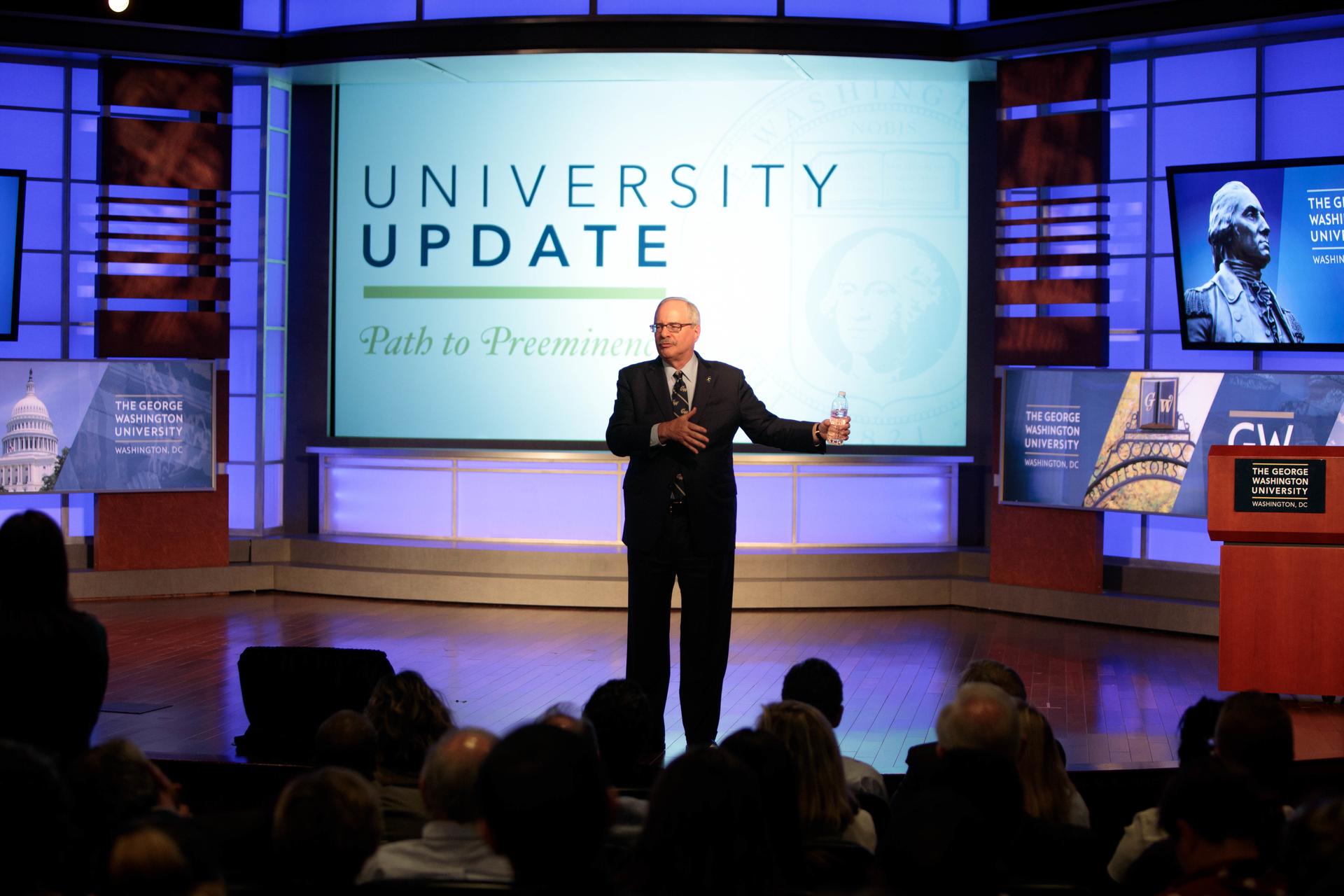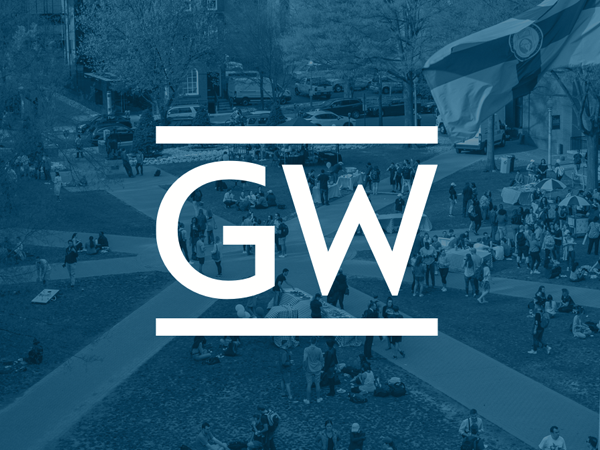George Washington University President Thomas LeBlanc on Thursday urged students, faculty and staff to play an active role as the university launches its formal strategic planning process.
“We have an opportunity to see ahead to the institution we want to become, to anticipate our role in the ever-evolving world around us,” Dr. LeBlanc said at the University Update event at Jack Morton Auditorium, in which he officially launched the formal strategic planning process and took questions from the university community. “I want to challenge our community to see beyond the status quo. Together, let us look at our strengths and opportunities unbounded by the here and now. Let us imagine how we can become the university the future demands and to which we all aspire.”
Dr. LeBlanc also announced the formation of four faculty-led committees, one for each of the four pillars of the strategic plan: world-class faculty, high-quality undergraduate education, distinguished and distinctive graduate education, and high-impact research.
“Each committee will include faculty, staff and students and will be charged with three main tasks: gathering input from our community, assessing the current state of that area of our work and examining best practices, and proposing recommendations to achieve preeminence and identifying challenges to doing so,” Dr. LeBlanc said.
Chairs and vice chairs of the committees have been established and the university is working now to identify additional faculty, student and staff membership. A current list is available on the strategic plan website.
Beginning his address, Dr. LeBlanc summarized the work that has already been done in anticipation of establishing a formal strategic plan. In his first years as president, listening sessions, meetings and town halls with university constituents helped establish the shared aspiration that gives broad shape to the strategic plan.
“Our aspirational statement [is that] GW aspires to preeminence as a comprehensive global research university,” Dr. LeBlanc said.
He also laid out the university’s existing resources and recent successes, including its $1.4 billion endowment, the prestigious research achievements of its faculty and its increasing focus on the student experience, culture and building community on and beyond campus.
“Our foundation is strong,” Dr. LeBlanc said. “GW, unlike some other institutions in higher education, is not experiencing a crisis. We are in a good place, and that allows us to think strategically about our future.”
Two specific objectives included in the framework of the strategic plan, established in concert with academic leadership and the Board of Trustees, “are critical to moving the university toward preeminence,” Dr. LeBlanc said.
Watch Dr. LeBlanc's full address on Vimeo. A transcript of Dr. LeBlanc's opening remarks is availble here.
Increasing STEM majors
“The world is changing, and STEM is an accelerator,” Dr. LeBlanc said. “We should all want every student at this university to have access to the skills necessary for the quantitative analysis of data using technology. These skills are transforming every discipline and even the nature of work, and regardless of students’ field or industry, their success in our modern world requires this knowledge.”
But Dr. LeBlanc emphasized that increasing GW’s number of STEM majors would not come at the expense of GW’s historic strengths in political science, journalism, public policy, law and other areas.
“Our STEM aspiration is an ‘and’ not ‘or’ effort,” he said. “I have no intention of undermining what has defined this university for generations. In fact, just the opposite: We need to enhance our strengths in those areas. We must bring together expertise across an array of disciplines to compound the influence of our traditional strengths.”
GW’s current population of undergraduate STEM majors stands at about 19 percent—the second-lowest percentage among private research universities, Dr. LeBlanc said. Increasing that to 30 percent would include counting second majors.
“We are trying to increase the discourse on campus that is informed by these disciplines,” Dr. LeBlanc said.
He pointed to the establishment of the Institute for Data, Democracy and Politics as an example of what GW’s traditional strengths could achieve when paired with expertise in STEM.
Dr. LeBlanc also said that increasing the school’s number of STEM majors, and integrating them better into the university at large, would be a recruitment advantage, too.
“If you want to be in D.C. and study in these fields, that’s a true advantage for us,” he said.
‘Right-sizing’ the on-campus undergraduate population
“In two years of study, I cannot think of a single other thing we could do that would have as positive an impact on the undergraduate student experience as reducing the size,” Dr. LeBlanc said.
Over the past few years, the student population has risen to the point that it now meets the District of Columbia’s population cap, Dr. LeBlanc said.
“We’ve added a significant number of students over the last five years, and we have stretched our facilities, our class offerings, our faculty advisers, in so many dimensions that it is having a negative impact on the student experience.”
In response to a question from a staff member, Dr. LeBlanc was clear that reducing the on-campus undergraduate population by 20 percent over five years would not represent a corresponding 20 percent reduction in university revenue.
“We are a $1.4 billion enterprise with many different revenue streams” of which undergraduate tuition is only one, he said. “The actual impact on the budget of the projected decline in revenue is something less than 6 percent. That’s about 1.1 percent a year for five years.”
Still, he said, “We will have to make choices.”
“But we can’t build a great institution on the back of salary freezes, or letting all your faculty go, or eliminating departments,” Dr. LeBlanc said. “We can do this effort without the dramatic extreme measures some people are concerned about.”
In response to a question from a student, Dr. LeBlanc said reducing the on-campus undergraduate population would accordingly reduce housing demand—creating new possibilities for the future of the Mount Vernon campus in particular.
“I’m excited about the possibilities,” he said.
Call for participation
Responding to a question submitted by a student, Dr. LeBlanc said undergraduate and graduate students would be included on the planning committees. He encouraged students, as well as staff, faculty, alumni and other stakeholders, to submit ideas, questions and concerns using the online submission form on the strategic plan website.
“We need your ideas and input,” Dr. LeBlanc told the audience. “I urge you to share your feedback on the site now, and share it often. Share it every time you have an idea.”



